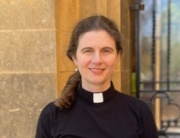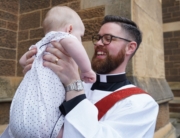The Rev’d Dr Lynn Arnold AO
WE WILL REMEMBER THEM
May the words of my mouth and the meditations of our hearts be worthy in your sight, O Lord, our Rock and our Redeemer. Amen
Today is ANZAC Day, a day which is perhaps more truly our national day than Australia Day for it can be thought of as representing a birth of the Australian people rather than the Australian nation. This is so because it had as its founding act, not a colonial constitutional convention but an event of pyrrhic heroism characterised by images of profound sacrifice, bravery beyond normal comprehension along with a generous-hearted camaraderie which all started in the predawn of April 25 1915. I am very grateful to our own Gerald Lipman for letting me read a letter written by his maternal grandfather, Guy Fisher, who was amongst those who took part in that landing.
The moon didn’t set till three and it began to get daylight at four so we had to try and land between those hours. I don’t know quite what it felt like during those last few hours on the destroyer; very highly strung and excited but I don’t think … any of us realised it enough to be frightened … We were just ready to get into the boats when they started first one shot then two more and then a perfect hail of bullets. The Turks were shooting badly and we got right into shore and were just getting out when I got mine through the right arm just by the elbow, it knocked me into the sea and I had to scramble for the shore … Then the big guns and machine guns started on us and it was absolute hell!
Seriously wounded, Guy Fisher lay there for nine hours before he was evacuated to a hospital ship and so watched at close quarters the unfolding battle commenting in his letter:
We were at a great disadvantage this first day as we had no field artillery ashore and consequently the enemy had it all their own way in that line; they caused us some very heavy losses … there were some ghastly sights …
After medical treatment in Cairo, Guy Fisher returned to Gallipoli on 20 June to rejoin the fight. There is a photo in the National War Memorial in Canberra of Guy and eight other men all from the 10th Battalion AIF. Four of the men in the photo were killed at or soon after the landing while one was to die in action two years later. Of the remaining four, the National War Memorial notation to the photo mentions an Eric Meldrum who ‘survived the war but not the peace, taking his own life in 1922’ bringing to six those who did not grow old from the nine in the photo.
The motto of the 10th Battalion is Pro Patria – for Country. Yet it seems that the ANZAC tradition which grew from that landing on 25th April and all that followed saw a level of engagement which went way beyond mere patriotism or fighting for a cause; for the were fighting for each other and for family, for friends, and for community back home – an act of loving their neighbour as themselves. A friend and former classmate of mine, Colin Best, has lent me a commemorative book (The ANZAC Memorial) which was published in Sydney only a year after the landing as part of the first Australian ANZAC Day commemoration. Part of the book consists of ‘Soldiers stories’, whilst another is entitled ‘Military Despatches’. One of the despatches included a report from Major-General Alexander Godley of the New Zealand contingent commenting on the ANZACs:
I cannot close my report without placing on record my unbounded admiration of the work performed and the gallantry displayed by the troops and their leaders during the severe fighting. [p190]
British General Ian Hamilton, who quoted Godley, also wrote:
Though Australian, New Zealand and Indian units had been confined to trench duty in a cramped space for some four months, and though the troops of the New Armies had only just landed from a sea voyage, and many of them had not been previously under fire, I do not believe that any troops in the world could have accomplished more.
Deservedly we have the annual commitment never to forget; and at the end of our service this evening we will stand for the Ode:
They shall grow not old, as we that are left grow old;
Age shall not weary them, nor the years condemn.
At the going down of the sun and in the morning
We will remember them.
After my sermon we will hear the choir sing John Ireland’s anthem ‘Greater Love hath no man’ which contains the famous couplet:
Greater Love hath no man than this
That a man lay down his life for his friends.
The next line in that anthem, however, brings us back to the fact that we are in a place of worship with the anthem’s reference to Christ’s laying down of his own life:
Who by his own self bare our sins in his own body on the tree,
That we, being dead to sins, should live unto righteousness.
As a follower of Christ, I have reflected a great deal over how to approach the question of warfare. In 2010, on the afternoon of ANZAC Day that year, I wrote a piece about my ongoing struggle of trying to bring into consonance going to war with Jesus’ second greatest commandment to ‘love my neighbour as myself’ [Mark 12:31] and his instruction that we should ‘love (our) enemy, (and) do good to those who despitefully use (us)’ [Matthew 5:44]. I put the dilemma this way:
I have never been able to accept the concept of a Just War and yet have undeniably felt that there is a cause of relative ‘rightness’ in some conflicts – the Second World War and the Vietnamese-Cambodia War of 1979 as two examples. But my theology does not allow me to pretend that there is ever a sense of Dieu et mon droit to conflict – of conflicts that would be blessed by God.
This has led me to feel that, here in a place of worship, our response to war should be one of sorrow for our collective failure as humanity that has given rise to deeply broken worldly relations, grief for those who have become victims of that brokenness and prayer for God’s peace to be with us all. Indeed, the Collect for Peace tonight highlighted that only God can give us true peace – recall this line:
Give unto thy servants that peace which the world cannot give.
Quoting again from my piece on ANZAC Day, I wrote:
To return to the heroism remembered on ANZAC Day, it has long seemed to me that it is a heroism of innocence rather than triumphalism – or if there is a triumphalist sense, it is of the triumph of the human spirit.
In that 1916 book ANZAC Memorial there are a number of the entries which echo this heroism of innocence. Those soldiers had been called to battle and knew their duty was to be victorious which would inevitably mean defeating the enemy, even at the cost of killing some of them. But no blind hatred of the enemy came through in those letters. Private Cashman, relating an incident on 28/04/1915 when a Turkish commander had led multiple bloody attacks against him and his comrades, wrote:
This is the bravest act I saw while at the front, although it was performed by a Turk. [p54]
And R J Kenny of the 4th Battalion, told of the aftermath of an attack on April 26 when a wounded Australian soldier lay near Turkish lines crying out ‘For God’s sake, cobbers, bring me water! Don’t let a man stay here!’. Kenny continued:
Towards morning the cries ceased and I hope the Turks took the man away and attended to him. They were very good to our wounded, and I’m sure if they found him alive he has been fixed up. [p61]
Indeed, it seems as if a strange camaraderie existed across the line separating the combatants. Pte E R Jeffree related an incident in June 1915 of a soldier who was the ongoing target of a Turkish sniper:
Every time the Turk fired the lad would duck; and when he emerged, he would wave his hand in signaller’s fashion to indicate a miss. [p68]
Lance Corporal George Garland wrote of a sacrificial event on 22nd August when, seriously wounded, he was saved by another equally badly wounded soldier who gave all his remaining energy and effort to rescuing Garland. He wrote this of his rescuer:
(Private Tuckwell) bestowed upon me that quality of kindness which brings a man very close to Christ. Some perhaps would call it a brave act; but bravery is a common quality shared by all men who have the spirit to go into a foreign land and meet the enemies of their country in battle … I choose to call Private Tuckwell’s act one of unselfish devotion and kindness. Yes, the kindest act of many kind acts. [p76]
This morning at the National War Memorial on North Terrace the traditional Dawn Service was held once again. This beautiful and moving monument was co-designed by Walter Bagot (Louis Laybourne-Smith completing it). Walter had also been the architect of the completion of another sacred place – this Cathedral. The Memorial, entitled ‘The Spirit of Sacrifice’ has two faces – one facing the dawn entitled ‘Spirit of Duty’ which is fronted by a statue of three young persons (a student, a farmer and a girl) laying aside their tools to respond to the call; and the reverse side, facing the twilight, entitled ‘Spirit of Compassion’ with a winged spirit holding in its arms the ‘limp figure of a fallen hero’. In these two faces, the monument tells the story of war without celebrating the violence of conflict (as some memorials do with drawn guns and other armed weaponry such as cannon at the ready) instead it mourns its tragedy. Indeed, it is not only a War Memorial but also a Cenotaph (which is an empty tomb), for within it are the names of the 5511 South Australians who died during the war which have been cast in bronze. It has been said that the Memorial is not ‘a work displaying a material victory, but instead a victory of the spirit.’
At the Memorial’s opening, the then Governor, Sir Alexander Hore-Ruthven said:
It is not only for ourselves that we have erected this visible remembrance of great deeds, but rather that those who come after us and have not experienced the horrors of war, or realised the wanton destruction and utter futility of it all, may be inspired to devise some better means to settle international disputes other than by international slaughter. This memorial is the seal of South Australia’s homage …
Each ANZAC Day, we say we will remember them – may we ever do so, remembering as we do that brokenness of the human condition which gave rise to such dreadful suffering and never forgetting that Christ beckons us away to the peace that God offers. And so, I finish with the word which means ‘so be it’ – Amen.





